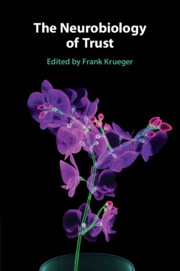Book contents
- The Neurobiology of Trust
- The Neurobiology of Trust
- Copyright page
- Dedication
- Contents
- Figures
- Tables
- Contributors
- Abbreviations
- Introduction
- Part I Fundamental Level of Trust
- Part II Neuropsychological Level of Trust
- Part III Neurocharacteristic Level of Trust
- Part IV Neuromolecular Level of Trust
- Chapter 13 Trust and Oxytocin
- Chapter 14 Trust and Psychopharmaca:
- Chapter 15 Trust and Genetics
- Part V Neuropathological Level of Trust
- Index
- References
Chapter 13 - Trust and Oxytocin
Context-Dependent Exogenous and Endogenous Modulation of Trust
from Part IV - Neuromolecular Level of Trust
Published online by Cambridge University Press: 09 December 2021
- The Neurobiology of Trust
- The Neurobiology of Trust
- Copyright page
- Dedication
- Contents
- Figures
- Tables
- Contributors
- Abbreviations
- Introduction
- Part I Fundamental Level of Trust
- Part II Neuropsychological Level of Trust
- Part III Neurocharacteristic Level of Trust
- Part IV Neuromolecular Level of Trust
- Chapter 13 Trust and Oxytocin
- Chapter 14 Trust and Psychopharmaca:
- Chapter 15 Trust and Genetics
- Part V Neuropathological Level of Trust
- Index
- References
Summary
The neuropeptide oxytocin (OXT) has been linked to interpersonal trust. While initial behavioral studies demonstrated a facilitating effect of OXT on trusting behavior, more recently these findings have been challenged. In this chapter we review the literature reporting two approaches that are used to evaluate OXT’s effects: exogenous OXT administration and the investigation of the endogenous OXT system. With respect to trust, we report results from studies investigating trusting behavior, mostly using economic games, and studies looking on the intention to trust other individuals. Overall, clear evidence for a direct trust-promoting effect of OXT as proposed by early studies cannot be found. Instead, there is evidence that the relationship between OXT and trust is modulated by manifold contextual factors that are closely interrelated, e.g., social affiliation, personality traits, gender, mental disorders, and genetic disposition. Furthermore, it could be argued that the effect of OXT on trust is not a specific one but only a subphenomenon of the more general prosocial effect of the neuropeptide.
Future research should aim to conceive models of the OXT–trust connection considering the interactions between genes, brain functioning, and the environment, advancing the knowledge of understanding interpersonal trust.
Keywords
- Type
- Chapter
- Information
- The Neurobiology of Trust , pp. 315 - 337Publisher: Cambridge University PressPrint publication year: 2021
References
- 2
- Cited by



